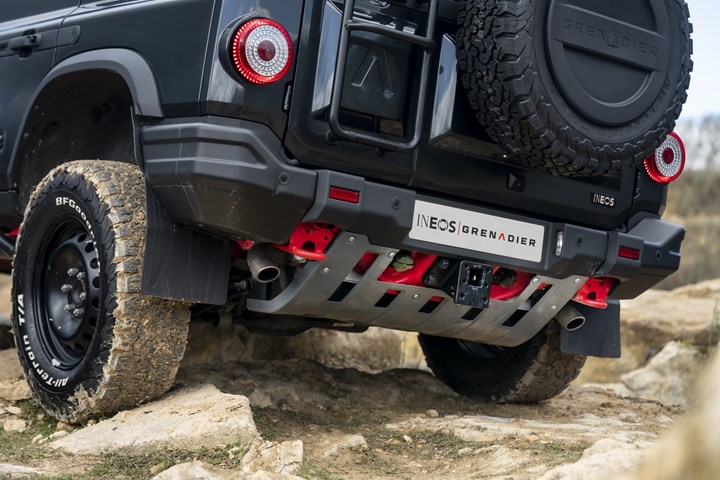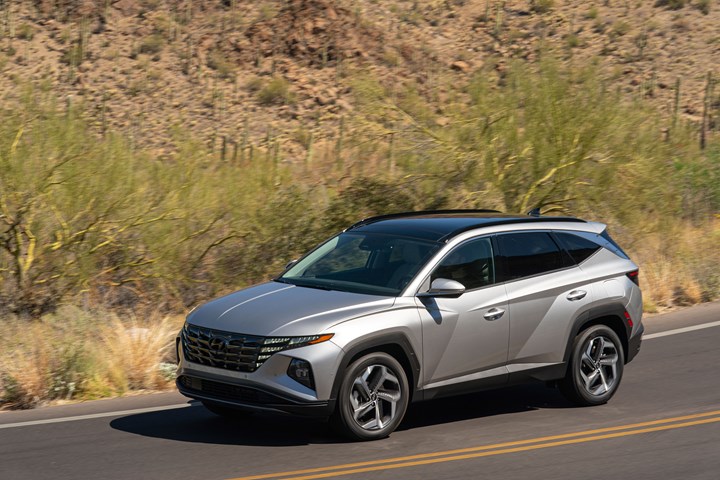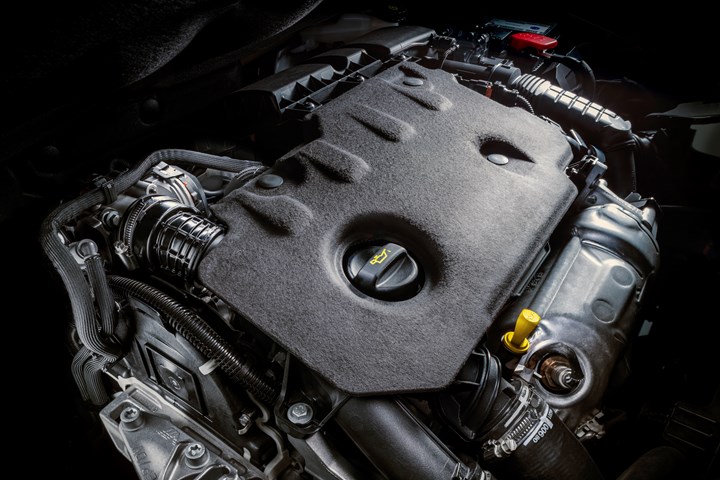on gigacasting, Stellantis investments, Ford's Euro EV factory, VW achieving aero, Hyundai Tucson Hybrid
What gigacastings are. . .Stellantis investments. . .Ford EV factory in Europe. . .making an aero EV sedan. . .powder coating for charity. . .Hyundai Tucson Hybrid. . .diesels in Europe. . .
#hybrid
About Those Big Castings

Big Bühler casting machine. (Image: Bühler)
You’ve heard about “gigacastings” or “megacastings.”
And possibly nod knowingly when you hear someone mention them. Not exactly having much of a notion of what this is about.
Last week a Swiss company, Bühler, introduced a new machine to perform the process.
The machine, the Carat 840, is 25 feet high. It takes up some 1,722 square feet on a factory floor. (If you look carefully at the left side of the picture above you can see some stools, which provide a bit of scale.)
It can inject over 440 pounds of liquid aluminum into a die in milliseconds.
And because that aluminum could be at 1,400°F, it is important that the two halves of the die stay together (i.e., shoving in that quantity of aluminum at a high rate means a considerable amount of pressure), there are 8,400 tons of locking force (meaning the die is held really tight).
“The future of the automotive market is being shaped by various forces. The main factors today are reducing complexity, increasing productivity, and improving sustainability.”--Cornel Mendler, Managing Director Die Casting at Bühler Group
- Reducing complexity: 70 to 100 parts (like stampings) can be replaced by a single diecasting
- Increasing productivity: Beyond the process itself being comparatively fast, think of having to assemble (weld, glue, fasten) 70 to 100 individual parts
- Improving sustainability: Citing internal research, Bühler has found that if low CO2e aluminum alloys are used and renewable energy is used in the process, CO2e emissions can be reduced by up to 70%
Trending Tech
Much to the chagrin of those in the metal stamping community, an increasing number of OEMs are using these large castings for their bodies-in-white or intend to.
For example, last week, when it announced it was going to be producing 1.7-million battery electric vehicles by 2026 and that it is working on batteries and aerodynamics such that an EV can have 620 miles of cruising range, Toyota execs said:
“On the manufacturing axis, the car body will be constructed from three main components in a new modular structure. Adopting giga casting will allow significant component integration, which contributes to the reduction of vehicle development costs and factory investment.”
Keep in mind that Toyota is the largest OEM in the world, so it is going to be making a mega number of gigacastings.

Examples of Toyota’s gigacastings. (Image: Toyota)
///
Investing in the Future
Stellantis Ventures was established last year as part of the Stellantis Dare Forward 2030 plan.
The key thing to know about that plan:
“By 2030, we expect our Net Revenues to double to €300 billion, driven primarily by:
- Increase in mix of Battery Electric Vehicle sales, which will account for more than 50% of global revenues in 2030 (vs 3% in 2021)
- Strong growth in our software and services businesses, projected to represent 20% of total revenues in 2030
- Revenue growth outside of North America and Enlarged Europe, more than 25% of our Net Revenues coming from outside those two regions (vs 15% in 2021)
- New car revenues from our premium and luxury brands, which will increase from 4% in 2021 to 11%”
So a big focus on EVs and software and services (i.e., 70% of global revenues).
Stellantis Ventures was established with an investment of €300 million. Last week Adam Bazih, the firm’s managing partner, said that about of third of that is being invested in 10 startups, as well as a mobility venture fund.
Not surprisingly, there are investments in companies including Lyten, a company that is developing lithium-sulfur batteries, and Nauto, which has an AI-based collision-prevention system.
Going on Two Wheels
But one on the list seems a bit. . .unusual: Beweelsociety.
Bazih says that it was an organization that actually spun out of Stellantis.
The company describes itself on its LinkedIn page:
“BEWEELSOCIETY is a company based in Lyon, bringing together an internal and external skills network, a committed ecosystem bringing together perfect knowledge of the cycle market, the uses of cycling communities, and the needs for individuals and professionals. . . . BEWEELSOCIETY co-designs ultra-connected electric and muscular bikes for major iconic brands concerned about their environmental impact.”
Yes, a bicycle-based mobility firm.
But Bazih notes that this isn’t at all unusual: Stellantis brand Peugeot was building bicycles before it got into car manufacturing: 1882 vs. 1890.
Micromobility is certainly a growing approach to going places.
One goal of Beweelsociety seems as though it might not exactly be consonant with what Stellantis is pursuing: “to make the bicycle the reference mobility of the 21st century.”
///
Blue Oval Green in Cologne

Ford retools plant in Cologne to produce EVs. (Image: Ford)
While on the subject of Europe. . .
Ford has been making vehicles in a plant in Cologne, Germany since 1930, when the Model A went into production there.
Now, after making a $2-billion investment in the facility, the Cologne Electric Vehicle Center is producing an electric Explorer, which should not be confused with the Explorer that you might have in your driveway.
The Euro Explorer is based on the Volkswagen MEB platform.
(As you may recall, Ford and VW established a partnership in 2019. VW is using the underpinnings of the Ford Ranger for its Amarok pickup.)
The 309-acre Cologne complex has a new production line, battery assembly, and automation, including collaborative robots (cobots).
One thing that makes the Cologne plant different than any other Ford assembly plant anywhere (for now): it is Ford’s first carbon-neutral assembly plant.
How do they do that? Through things like using 100% certified renewable electricity and biomethane.
Martin Sander, general manager, Ford Model e Europe:
“The carbon neutral Cologne EV Center is a leading automotive industry showcase for the switch from traditional auto manufacturing to electric vehicle production. The facilities and processes have been designed by our engineers to maximize efficiency and minimize environmental impact, helping Ford become carbon neutral in Europe and supporting our global decarbonization plan.”
Ford plans to become fully carbon neutral in Europe by 2035.
///
Getting ID.7’s Aero

How to create an aerodynamic sedan. (Image: VW)
And while on the subject of VW and EVs. . .
Volkswagen is launching a new sedan in Europe and China later this year and in the U.S. next. The ID.7.
This is a long, lean sedan. Thomas Schäfer, CEO of Volkswagen Passenger Cars, describes it as a “limousine” that “offers a high level of comfort and long ranges.”
This range is predicated on an efficient 210-kW drive motor and an 86-kWh battery that will provide an estimated range of 700 km (435 miles) on the WLTP test cyle.
And another aspect of range is aerodynamics.
According to VW, for a vehicle like the ID.7:
- ~50% of the coefficient of drag (Cd) is based on the body shape
- 30% on the wheels and tires
- 10% on the underbody
- 10% on the functional air openings
The Cd for the ID.7 is 0.23.
Volkswagen designer Daniel Scharfschwerdt:
“When designing the ID.7, there was a greater focus on aerodynamics than for practically any other model. This can be seen in the low front end, the flowing transition into the bonnet, and the fast windscreen. The coupé-like roof form and the tapering rear end are also designed for ideal aerodynamic performance.”
But while Design can come up with remarkably aerodynamic forms, there is the issue of those designs being practical from the standpoints of things like packaging (after all, you need space for the motor and battery, to say nothing of occupants) and manufacturing.
Which means that others have to get into the process.
Stephan Lansmann, project engineer responsible for ID.7 aerodynamics:
“We strive for ideal solutions in an iterative process, which includes regular consultation between the Development and Design departments. There are many small steps here that pay off in the end.”
Even a vehicle that’s said to be about 16 feet long is a series of small elements. Optimizing them can make big differences.
///
Powder Coating for Good

Those who opt for a special color coating on the chassis of their Grenadier result in a charitable donation. (Image: INEOS Automotive)
Chances are you don’t think a great deal (or at all) about the coating of your vehicle’s chassis.
But customers of the INEOS Automotive Grenadier, a rugged, utilitarian 4x4 (with a starting price of £49,000, or about $63,000, but know that it is not available in the U.S. market), might want to select one of the two optional colors to coat the vehicle’s ladder frame.
There are two optional finishes:
- Rhino Grey
- HALO Red
INEOS is making a charitable contribution of €150 to one of two organizations based on the selection.
- Rhino Grey chassis provide a contribution to The Rhino Orphanage, a rescue center for rhino calves based on the Limpopo Province of South Africa.
- HALO Red benefits The HALO Trust, a global landmine clearance charity that trains people within communities that have been affected by conflicts to safely remove the ordnance.
The fully boxed frame, incidentally, is up to 3.5-mm thick in sections, is fully E-coated, has an interior wax application, and is powder coated.
And if that grey or red are selected, that powder coating does more than help contribute to the ladder frame’s 12-year anti-perforation warranty.
///
2023 Hyundai Tucson Hybrid Limited

2023 Tucson Hybrid: creative styling and great fuel economy. (Image: Hyundai)
There are but a handful of mainstream compact SUVs out there. . .with a hybrid powertrain. Otherwise, there are plenty to choose from. Somehow the hybrid aspect doesn’t seem to be all that interesting to some OEMs.
But there are some vehicles with hybrid powertrains available in this category, including the Ford Escape Hybrid, the Kia Sportage Hybrid, Honda CR-V Hybrid, and the Toyota RAV4 Hybrid.
Objects of Interest
Turns out that small hybrid SUVs are of interest to consumers.
That is, when it reports its sales numbers Toyota indicates how many hybrid versions of its models it sells.
In Q1 2023 it sold 19,633 RAV4 Hybrids. During the same period, General Motors, which doesn’t equip the Chevy Equinox with a hybrid powertrain, delivered 52,902 of those utes.
In other words, the hybrid version of the RAV4 was equal to about 37% of all Equinox sales.
You’d think that GM might reconsider its plan to no longer offer hybrids.
But this is about neither the RAV4 Hybrid nor the Equinox. They are used for numeric purposes only.
It is about the 2023 Hyundai Tucson Hybrid.
Which, as has been the case with plenty of Hyundais of late, is a highly competitive vehicle in the category, something that anyone who is thinking about a hybrid SUV ought to put in their competitive set.
Design & Dimensions
There was a major change to the Tucson from model year 2021 to ’22, both in terms of design and dimensions.
As for the former, SangYup Lee, senior vice president and head of the Hyundai Global Design Center, said, “We pursue innovation solutions in design and add emotional value to our product experience thought our Sensuous Sportiness design identity.”
While I am not entirely sure what the affective aspect of the design is, there is evident sportiness, which is predicated in large part by another approach that the Hyundai designers take: “Parametric Dynamics.”
The best way to understand that is to simply look at the body side of the Tucson, where there are diagonal creases, something that aren’t found on other vehicles no matter what the brand or body style.
Designers often say a given vehicle design is “dynamic.”
Hyundai designers didn’t say it. They show it.
Dimensionally, the vehicle is 182.3 inches long (6.1 inches more than the previous model), 73.4 inches wide, 65.6 inches high, and has a wheelbase of 108.5 inches. (All of those subsequent measures, like that of the length, are greater than what was.)
As this is a utility vehicle, know that it offers 38.7 cubic feet of space behind the second row and 74.5 cubic feet when that row is folded.
But here are some numbers that are notable.
A Long Way
The EPA estimated fuel efficiency numbers are 37 mpg city, 36 mpg highway and 37 mpg combined.
Take the combined 37 and multiply it by 13.7, the number of gallons the gas tank contains, and you have a range of 506.9 miles.
And know that those aren’t miles that you’re going to rack up in some sort of molasses mode.
The vehicle is equipped with a 1.6-liter, turbocharged four that produces 189 hp and a 44.2-kW electric motor. Together they provide a system horsepower of 226. As there is also an on-demand AWD system, if you get on the throttle you are going to find that the Tucson Hybrid SUV is rather responsive for what it is.
There is also an abundance of tech for purposes of safety—like forward collision-avoidance assist with pedestrian/cyclist/junction turning detection, lane-keeping and lane-following assist, and (in the Limited trim) navigation-based smart cruise control with curve control (i.e., it uses the map info in order to adjust the speed when going into a curve).
And there’s tech for infotainment accessed through a 10.25-inch color touch screen, such as SiriusXM, Android Auto and Apple CarPlay, and (again, the Limited model) a Bose Premium Audio system.
Consider
If you build a spreadsheet of specs and features to compare vehicles, then the Tucson Hybrid is going to be right in there.
But when you are buying a vehicle (and know the starting MSRP for the Limited version is $39,110), there is more than a smidge of feeling involved—feeling both as regards what your experience is sitting behind the wheel and assessing the environment and amenities and feeling in terms of how the vehicle represents what you are.
As dealers are still something that brands like Hyundai use, go take a ride in the vehicle (and others you may have on your list) and use that to help decide.
///
Diesels: Down. . .and Up

An Opel turbo diesel. Yes, you can still buy a light vehicle with a diesel in Europe—and a non-trivial number of people do. (Image: Opel)
Although the light vehicle diesel decline in Western Europe continues, it isn’t quite as severe as you might think.
In fact, LMC Automotive notes, “volume-wise the diesel market, though much depleted over recent years, is reasonably robust, with decline continuing at a modest pace, currently around 0.25 pp per month.”
And the decline is not evenly distributed.
For example, LMC found that in Germany May ‘23 diesel sales were 64,700 units, up from 54,100 in May ‘22. This is not just a one-month anomaly either, as year-to-date (through May) German diesel sales are 293,700 up from 268,500 the previous year.
Overall, however, on a percentage basis, the provisional numbers for May ‘23 have diesel sales (including hybrids) at 16.8% of the new car market, down from 19.5% in May ‘22.
However, the firm finds that in terms of units sold there was actually an increase: 169,300 diesels in May ‘23 vs. 164,000 in May ’22.
LMC says that while the number of diesels being purchased by individual consumers is comparatively low, fleet sales are good because business drivers tend to rack up more miles and diesel efficiency can help reduce costs.
Idle Thought
As the propulsion system transition occurs, recognize that sometimes things are not as they seem and that what might seem like yesterday’s approach continue to make a difference today. And will tomorrow.
~~~
RELATED CONTENT
-
Choosing the Right Fasteners for Automotive
PennEngineering makes hundreds of different fasteners for the automotive industry with standard and custom products as well as automated assembly solutions. Discover how they’re used and how to select the right one. (Sponsored Content)
-
When Automated Production Turning is the Low-Cost Option
For the right parts, or families of parts, an automated CNC turning cell is simply the least expensive way to produce high-quality parts. Here’s why.
-
On The Jeep Grand Cherokee, 2022 Nissan Pathfinder, and More
An inside look at the Detroit Assembly Complex-Mack; a innovative approach to waste-free, two-tone painting; why a forging press is like an F1 car; and other automotive developments.


.jpg;width=70;height=70;mode=crop)






